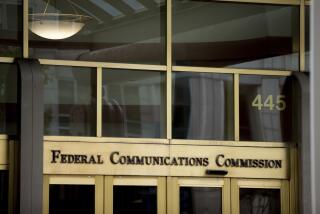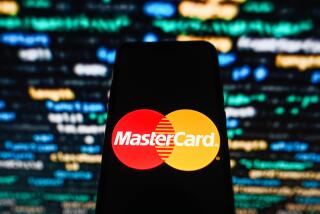Is the FCC ready to think outside the set-top box?
- Share via
reporting from WASHINGTON — That unsightly and costly metal box that funnels cable or satellite service into your TV might be going the way of the black rotary-dial telephone — in the technology trash heap.
A holdover from the early days of pay television, the set-top box is an energy-inhaling contraption that also sucks money from Americans’ wallets each month.
In a move that could further disrupt the changing video marketplace, those boxes soon could face new federal regulations designed to break the hold of Comcast, Verizon, DirecTV and other providers on the devices that millions of Americans depend on to watch TV.
About 99% of the nation’s 100 million pay TV subscribers lease a set-top box, with the average household paying $231 a year in rental fees, according to a survey by Sens. Edward Markey (D-Mass.) and Richard Blumenthal (D-Conn.).
Those costs are one reason a growing number of so-called cord cutters are dropping their conventional pay TV service and now are streaming programming over the Internet directly through smart TVs or via much smaller devices, such as Roku, Chromecast and Apple TV, that they can purchase instead of rent.
Set-top boxes typically cost less than $10 a month, but the average customer rents about 2.6 set-top boxes to cover multiple TVs. Those rentals generate about $19.5 billion a year in revenue for pay TV companies, so they’re not eager to open up the market to other manufacturers who could produce more innovative devices for viewers to buy, consumer advocates said.
Still, Time Warner Cable Inc., and some other providers are experimenting with their own customized apps that would enable customers to ditch the set-top box and access their programming on a variety of devices. Pay TV companies are warning against adding new federal mandates as video options rapidly evolve.
“There is no quicker way to disrupt this vibrancy that is creating the greatest TV programming in the world than for the government to try and fix something that isn’t broken,” said Brian Dietz, a spokesman for the National Cable & Telecommunications Assn. trade group.
The changes aren’t coming fast enough for some lawmakers and consumer advocates as well as tech companies such as Google Inc., which are eager to jump into the set-top box market. They want the Federal Communications Commission to require that pay TV providers make their services more easily compatible with third-party set-top boxes or similar devices.
“I think the time has arrived for the FCC to enable millions of Americans to access the enormous amount of content in new, innovative and less costly ways,” Markey said. “Any phone will work with any cellphone company and any video box should be able to work with any video company.”
Such a mandate could allow consumers to access their pay TV and streaming services through one device instead of having to switch between two or more. And it could lead to innovations such as an ability to search for programming across services to determine, for example, whether a movie is available on Netflix or on-demand via a pay TV provider.
“If the cable operators gave up control, I think we’d see a lot more innovation,” said John Bergmayer, a staff attorney at Public Knowledge, a consumer group that focuses on digital issues. “It would actually make cable a more appealing product.”
As a case in point, he pointed to another device Americans were required to rent for years before regulators stepped in and opened the market: the telephone.
In its monopoly days, AT&T Inc. prohibited any unauthorized device from being attached to its phone network. That left Americans paying a monthly fee to rent AT&T’s standard rotary telephone. Any color other than black cost extra.
Then, in a landmark 1968 case involving the Carterfone, a device that allowed telephone customers to have conversations with two-way radio users, the FCC ruled that AT&T was required to let its customers attach any lawful device to the network as long as it didn’t adversely affect it. The decision opened the door to innovations that reshaped voice communications, including the answering machine and wireless phones.
“The leasing of set-top boxes through the traditional cable provider has not only locked up the box, but also has locked the consumer in a box,” said Chip Pickering, chief executive of Incompas, a telecommunications trade group formerly called Comptel that includes Amazon, Google Fiber, Netflix and Sprint.
“It’s not only an outdated technology, but also an outdated business model similar to what the old Bell monopoly had with the leased rotary phone,” he said.
I think the time has arrived for the FCC to enable millions of Americans to access the enormous amount of content in new, innovative and less costly ways.
— Sen. Edward Markey
Last year, Congress directed the FCC to appoint a panel of experts to study whether there was a “way to create a more competitive market for set-top boxes that would not be “unduly burdensome.”
Only two of the top 10 pay TV companies — DirecTV and Dish Network — offer their set-top boxes for purchase by customers.
The FCC’s Downloadable Security Technology Advisory Committee was composed of representatives from pay TV companies, electronics manufacturers, consumer advocates and high-tech firms such as Google and Amazon. But the diverse group could not reach a consensus on the best way to increase competition in the set-top box market.
The committee’s report, released in August, gave recommendations for the two leading options, both of which are still largely in the conceptual stage.
One is the app-based approach backed by the pay TV industry.
Customers would download a provider-issued app via a smart TV or other device and have access to all the programming for which they’ve subscribed, including the ability to watch on mobile devices. But the content would be walled off within the provider’s app, unavailable to be used by other applications for services such as an all-encompassing programming guide that included options from streaming services such as Netflix or Hulu.
The second option, backed by a coalition of consumer groups, high-tech companies, and device manufacturers such as Vizio and TiVo, as well as Amazon, would mandate a standardized technology that would make it easier for third parties to sell their own set-top boxes. The approach, based on a concept known as AllVid, would break the individual provider’s hold on their content and allow it to be integrated into a device that offers other services and programming as well.
One reason pay TV companies don’t like the second option is that competitors might sell advertising around their content, which their customers already pay for.
Public comments on the report are due Monday, and the FCC is expected to propose new rules in the coming weeks.
“I don’t think that the Congress passed the legislation instructing us to take this action for the purpose of having an academic seminar, so I would anticipate there would be something forthcoming,” FCC Chairman Tom Wheeler said last month.
It’s the FCC’s second chance to fulfill Congress’ desire to open up the set-top box market.
A similar effort begun in the late 1990s led to the creation of the CableCard.
The credit card-sized device contains the provider’s encryption technology. The card can be inserted into a TV or other retail device, such as a TiVo set-top box, to enable subscribers to watch programming without leasing a box from their provider.
But the CableCard has failed to transform the set-top box market since it was introduced in 2000. Consumers still have to rent the card for $2 to $4 a month from their provider, which usually must send a technician to install it in the third-party device. Also, the card doesn’t work for interactive services, such as purchasing on-demand movies.
As of July 31, there were only 617,000 CableCards installed in third-party devices for customers of the nine largest cable operators, according to the FCC. That’s compared with 53 million set-top boxes from those companies.
The pay TV industry has said that the CableCard initiative has been costly and that it fears another ineffective FCC mandate. To try to speed adoption of the card, the FCC in 2007 required that it be installed in all new cable set-top boxes, which previously had integrated decryption technology. That mandate cost cable companies $1 billion, and the separate cards required the boxes to use more electricity, the National Cable & Telecommunications Assn. said.
The FCC must wrestle with difficult issues, including how to ensure the security of pay TV programming. That’s a big concern of the Motion Picture Assn. of America, which represents the six major Hollywood studios.
The MPAA prefers apps from pay TV providers that would wall off their content so that licensing and distribution agreements aren’t violated. So does Alfred Liggins, chairman of TV One, a cable network aimed at African Americans.
“As a programmer, what I don’t want is to have the government force the cable operators to open up the set-top box platform,” he said. “The tech companies are going to write their own programming, manipulate content and sell advertising around it.”
But the FCC’s advisory committee said the AllVid approach could protect content as well. Ellen Stutzman, who directs research and public policy for the Writers Guild of America, West, said provider-based apps would fail to open up the video market and keep pay TV companies, not consumers, in charge.
“If they control the set-top box market and are allowed to integrate the Internet video of their choice, they remain the content gatekeeper,” she said.
ALSO
UFO scares are the price we pay for secret missile tests, expert says
Restoration work begins on part of the Salton Sea
‘Shrimp Boy’ Chow finally goes to trial







